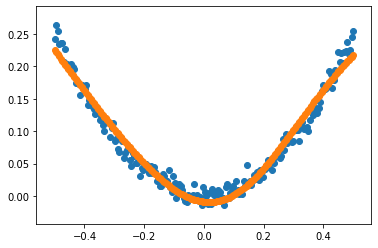定义常量
import tensorflow as tf # 定义常量 m1 = tf.constant([[3, 3]]) m2 = tf.constant([[2], [3]]) # 定义乘法 product = tf.matmul(m1, m2) # 这里不会直接输出结果,会打印出一个tensor # 想要输出结果要在sess中进行 print(product) # 第一种方式定义session sess = tf.Session() result = sess.run(product) print(result) sess.close() # 第二种方式定义session with tf.Session() as sess: print(sess.run(product)) sess.close()
结果:[[15]]
定义变量
import tensorflow as tf # 定义变量 x = tf.Variable([1, 2]) y = tf.Variable([3, 3]) sub = tf.subtract(x, y) add = tf.add(x, y) # 初始化所有变量 对于变量要进行初始化 init = tf.global_variables_initializer() # 在回话中进行结果 with tf.Session() as sess: sess.run(init) print(sess.run(sub)) print(sess.run(add))
结构:
[-2 -1] [4 5]
占位符
import tensorflow as tf
# Feed:先定义占位符,等需要的时候再传入数据 x1 = tf.placeholder(tf.float32) x2 = tf.placeholder(tf.float32) # 乘法操作 y = tf.multiply(x1, x2) # 使用的占位符元素在计算时要进行赋值运算 with tf.Session() as sess: print(sess.run(y, feed_dict={x1: 3, x2: 4}))
使用tensor进行线性回归
import tensorflow as tf import numpy as np import matplotlib.pyplot as plt # 随机初始化一批数据 x_data = np.random.rand(100) noise = np.random.normal(0, 0.01, x_data.shape) y_data = x_data * 0.1 + 0.2 + noise # 构建一个线性模型 d = tf.Variable(np.random.rand(1)) k = tf.Variable(np.random.rand(1)) y_pre = k*x_data + d # 定义loss值 loss = tf.losses.mean_squared_error(y_data, y_pre) # 定义优化器 使用优化器来优化loss optimezer = tf.train.GradientDescentOptimizer(0.3) train = optimezer.minimize(loss) # 初始化变量 init = tf.global_variables_initializer() with tf.Session() as sess: sess.run(init) for i in range(301): sess.run(train) if i % 30 == 0: print(i, sess.run([k, d])) y_pred = sess.run(y_pre) # 画出y_data和y_pred plt.scatter(x_data, y_data) plt.scatter(x_data, y_pred) plt.show()
结果:

非线性回归
import tensorflow as tf import numpy as np import matplotlib.pyplot as plt # 随机一批数据 x_data = np.linspace(-0.5, 0.5, 200)[:, np.newaxis] noise = np.random.normal(0, 0.01, x_data.shape) y_data = np.square(x_data) + noise # 构建非线性模型 # 定义两个占位符,用来添加x_data和y_data x = tf.placeholder(tf.float32, [None, 1]) y = tf.placeholder(tf.float32, [None, 1]) # 定义网络结构:定义只有一个隐藏层的权值矩阵 w1 = tf.Variable(tf.random_normal([1, 20])) b1 = tf.Variable(tf.zeros([20])) hider = tf.nn.tanh(tf.matmul(x, w1) + b1) w2 = tf.Variable(tf.random_normal([20, 1])) b2 = tf.Variable(tf.zeros([1])) out = tf.nn.tanh(tf.matmul(hider, w2)+b2) # 计算loss和定义优化器 loss = tf.losses.mean_squared_error(y, out) optimizer = tf.train.GradientDescentOptimizer(0.1) train = optimizer.minimize(loss) with tf.Session() as sess: init = tf.global_variables_initializer() sess.run(init) for i in range(8001): sess.run(train, feed_dict={x: x_data, y: y_data}) # 预测数据以及画出预测结构 y_pred = sess.run(out, feed_dict={x: x_data, y: y_data}) plt.scatter(x_data, y_data) plt.scatter(x_data, y_pred) plt.show()
结果:

使用BP神经网络训练mnist数据集
import tensorflow as tf from tensorflow.examples.tutorials.mnist import input_dataut_data # 载入mnist数据集 mnist = input_data.read_data_sets("mnist_data", one_hot=True) # 设置banch值 batch_size = 128 # 计算执行轮数 n_batch = mnist.train.num_examples // batch_size # 定义两个placeholder来存放数据 x = tf.placeholder(tf.float32, [None, 784]) y = tf.placeholder(tf.float32, [None, 10]) # 创建神经网络 784→10 W = tf.Variable(tf.random_normal([784, 10])) b = tf.Variable(tf.zeros(10)) prediction = tf.nn.softmax(tf.matmul(x, W) + b) # 定义损失函数和优化器 loss = tf.losses.mean_squared_error(y, prediction) train = tf.train.GradientDescentOptimizer(0.1).minimize(loss) # 计算准确率 correct_prediction = tf.equal(tf.argmax(y, 1), tf.argmax(prediction, 1)) accaracy = tf.reduce_mean(tf.cast(correct_prediction, tf.float32)) with tf.Session() as sess: sess.run(tf.global_variables_initializer()) for epch in range(51): for batch in range(n_batch): # 获取一个batch的数据 batch_xs, batch_ys = mnist.train.next_batch(batch_size) sess.run(train, feed_dict={x: batch_xs, y: batch_ys}) print("Iter: ", sess.run(accaracy, feed_dict={x: mnist.test.images, y: mnist.test.labels}))
结果:由于只有一层神经元,最终acc稳定在0.67附近
提升acc的方法:
1:建议把损失函数换成交叉熵;
2:建议加深网络,2-3层即可;
3:尝试改变优化器